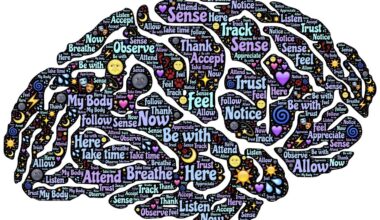Understanding the Energy Systems in Anaerobic Exercise
Anaerobic exercise primarily relies on two main energy systems: the phosphagen system and anaerobic glycolysis. The phosphagen system, also known as the ATP-CP system, provides immediate energy for high-intensity activities lasting up to about ten seconds. Energy is derived from adenosine triphosphate (ATP) and phosphocreatine (CP) stored in muscles. This system is crucial for short bursts of activity, such as sprinting or heavy lifting, where rapid force generation is essential. On the other hand, anaerobic glycolysis kicks in when the phosphagen stores deplete. This system allows the body to continue performing at high intensity for approximately 30 seconds to two minutes. Energy comes from the breakdown of glucose, resulting in the production of lactic acid when oxygen levels are inadequate. The accumulation of lactic acid is often associated with muscle fatigue and discomfort. Both energy systems are vital for athletes engaging in sports requiring intense effort. Understanding how these systems function enables athletes to optimize their training regimens, improving performance and preventing fatigue during important competitions.
In anaerobic training, it’s essential to incorporate specific workouts that target both energy systems effectively. High-intensity interval training (HIIT) serves as a powerful method, alternating short bursts of intense exercise with rest or lower intensity periods. This approach keeps the body in a state of anaerobic demand and encourages metabolic adaptations to improve performance. Exercises like sprinting, resistance training, and plyometrics are effective in maximizing the benefits of anaerobic training. Athletes can progressively increase the duration and intensity of their efforts as their capacity improves. Pairing anaerobic training with appropriate rest is crucial for recovery and muscle rebuilding. Recovery times vary depending on individual fitness levels and the intensity of sessions. Generally, allowing adequate recovery between intense efforts helps to avoid burnout and sustain performance capabilities over time. Additionally, nutrition plays a significant role in fueling anaerobic training. Consuming carbohydrates and proteins pre- and post-workout aids energy stores replenishment and muscle repair. Tailoring training and nutritional strategies to enhance both energy systems contributes greatly to athletic performance.
Benefits of Anaerobic Training
The advantages of anaerobic training extend beyond improving athletic performance. Engaging in such exercises leads to increased muscle strength and power, which are essential for various sports. Muscle hypertrophy occurs alongside strength gains as the fibers adapt to the demands placed upon them. Enhanced muscle mass contributes to overall metabolic rate increases, leading to better fat loss and body composition. Furthermore, anaerobic training improves bone density, crucial for injury prevention, particularly in athletes. The increased intensity of anaerobic workouts stimulates osteoblast activity, enhancing the structural integrity of bones. Another notable benefit is the improvement in glucose metabolism, which supports better insulin sensitivity. This can be particularly advantageous for those looking to manage weight or reduce the risk of type 2 diabetes. Additionally, anaerobic workouts can elevate cardiovascular health since the heart must work harder to supply oxygen. This increased demand strengthens the heart muscle and improves overall cardiovascular efficiency. Overall, the blend of strength, power, and health benefits makes anaerobic trainingan indispensable part of any comprehensive fitness program.
While the focus of anaerobic training is on short bursts of intense activity, it is essential to incorporate dynamic warm-up routines to prevent injuries. Warm-up exercises increase blood flow to the muscles, improving flexibility and reducing the risk of strains or tears. Including mobility drills and dynamic stretches prepares the body for higher intensity movements in various sports. Recovery and cooldown phases post-workout are equally important to moderate heart rate and gradually return the body to its pre-exercise state. Cooldowns often involve light physical activity alongside static stretching, enabling better mobility and relieving muscle tension. Keeping in mind the frequency of anaerobic training sessions is crucial; training too often without adequate recovery can lead to overtraining and burnout. Striking a balance between high-intensity workouts and rest days contributes to long-term performance gains. Educating athletes about monitoring their body’s response to anaerobic training is also key. Utilizing tools like heart rate monitors or subjective feedback can give valuable insights into recovery, ensuring athletes stay within optimal training parameters while achieving their performance goals.
Common Mistakes in Anaerobic Training
Many athletes make common errors when designing or participating in anaerobic training programs. One prevalent mistake is neglecting the importance of proper form during exercises. Improper technique can lead to injuries and limit performance gains. Ensuring that foundational movements are mastered is essential for long-term success in strength and conditioning. Another issue is overestimating recovery times. Athletes might push themselves to train intensely without giving muscles adequate time to recover, which can decrease overall effectiveness. This can lead to cumulative fatigue and plateaued progress. Furthermore, failing to incorporate variety into workouts can hinder growth; performing the same exercises repeatedly can lead to adaptation, which reduces gains over time. It’s vital to cycle through different modalities and intensities. Additionally, neglecting nutrition is a mistake that can compromise training results. Inadequate fueling, particularly around training sessions, can impair performance and hinder recovery. Lastly, some athletes focus excessively on anaerobic work, overlooking the benefits of aerobic conditioning, which contributes to overall endurance and recovery abilities. Finding the right balance is essential for sustainable progress.
Anaerobic training techniques can be integrated into a well-rounded fitness regimen to achieve maximum benefits. When combined with aerobic workouts, athletes can develop a comprehensive fitness strategy that supports both endurance and power outputs. Engaging in both training styles improves overall athletic performance. Being adaptable with training plans allows athletes to adjust their focus based on competition schedules, performance goals, and seasonal considerations. Through periodization, training can be strategically cycled between aerobic and anaerobic phases, helping athletes peak at the right times for competitions. Periodization simply means varying workouts over time to avoid plateaus and sustain enthusiasm and motivation. Furthermore, integrating cross-training into an athlete’s regimen helps prevent injuries associated with repetitive motions. Alternating between various sports or activities builds functional strength while using different muscles. Mindfulness about recovery and incorporating rest days is paramount in preventing injuries and allowing the body to respond optimally to training stress. Adapting to these various facets of training not only enhances results but also ensures longevity in one’s athletic endeavors. Embracing a holistic approach to fitness creates a greater potential for achieve long-lasting athletic success.
Conclusion
In conclusion, understanding the energy systems involved in anaerobic exercise is vital for athletes aiming to maximize their performance. The phosphagen system and anaerobic glycolysis both play critical roles in delivering energy during high-intensity activities. Structured training regimens that emphasize both energy pathways utilizing various methodologies such as HIIT can yield significant benefits in strength, speed, and power. Avoiding common pitfalls and focusing on proper form, fueling the body effectively, and integrating adequate recovery strategies can lead to substantial performance improvements. Beneficial adaptations extend not only to muscular strength and endurance but also to overall health markers, including weight management and cardiovascular efficiency. A strategic and informed approach to anaerobic training empowers athletes, enabling them to meet and exceed their personal performance goals. By appreciating the nuances of both energy systems, athletes can train smarter and harness their full potential in competitions. Ultimately, the goal should be not just to train harder, but also to train more effectively in a balanced manner. By doing so, it allows for sustainable growth and a lasting commitment to athletic excellence.
Effective anaerobic training not only boosts athletic performance but also contributes significantly to overall fitness and health. By understanding the energy systems involved and how to stimulate them effectively through targeted exercise modalities, individuals can experience enhanced strength, power, and speed. The balance afforded by combining anaerobic workouts with aerobic activities facilitates not only performance enhancements but also fosters healthy body composition and metabolic health. The knowledge gained through implementing rigorous anaerobic training can allow athletes to discover optimal strategies to employ both systems effectively in unison. Ultimately, individualizing training loads, recognizing the need for diverse workouts, and focusing on nutrition and recovery can create a synergistic approach to fitness. This multifaceted effort supports strong, capable bodies resistant to injury while also paving the way to sustained athletic excellence. The intricate relationship between both energy systems demonstrates the necessity for a comprehensive understanding of how anaerobic training can yield significant physical benefits. Embracing this knowledge serves as a pathway to implementing effective fitness strategies, fostering both immediate gains and long-lasting health effects throughout an individual’s athletic journey.


